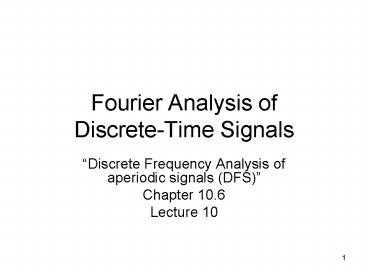Fourier Analysis of DiscreteTime Signals - PowerPoint PPT Presentation
1 / 13
Title:
Fourier Analysis of DiscreteTime Signals
Description:
What type of signals do we normally work with? Is this signal periodic? 5. DFT intro ... Now let's make this periodic and use DTFS. 7. 8. Example Lecture 9, 8 ... – PowerPoint PPT presentation
Number of Views:80
Avg rating:3.0/5.0
Title: Fourier Analysis of DiscreteTime Signals
1
Fourier Analysis of Discrete-Time Signals
- Discrete Frequency Analysis of aperiodic signals
(DFS) - Chapter 10.6
- Lecture 10
2
Types of Fourier functions
3
DFT intro
- Title page said analysis of Aperiodic signals
- Chart places the DFT (FFT or DFS) into same
bracket of DTFS (periodic signals) - What gives?
- If we have a perfectly periodic signal, great!
- Use DTFS
- If we have an aperiodic signal, must use DTFT
- Problem! What is it?
4
- Clicker Q
- What major problem with the DTFT?
- What type of signals do we normally work with?
- Is this signal periodic?
5
DFT intro
- Title page said analysis of Aperiodic signals
- Chart places the DFT (FFT or DFS) into same
bracket of DTFS (periodic signals) - What gives?
- If we have a perfectly periodic signal, great!
- Use DTFS
- If we have an aperiodic signal, must use DTFT
- Problem! What is it?
- By using the DFT and assuming the aperiodic
signal IS periodic we achieve a discrete output
for aperiodic signals! Truly the DSP WORKHORSE
6
Lets see how the DFT works
- Lets assume we have a finite length signal, xn
- Now lets make this periodic and use DTFS
7
(No Transcript)
8
Example Lecture 9, slide 8
- From Lecture 9 the DTFT
- X(O) 1-e-jO
- X(O) v(1-cosO) sin2(O)
- plot
- Now, the DFT
- NDr NSn0 xn e-jpnr
- ND0
- ND1
9
DFT properties
- Time shift
- Differentiation
10
Circular Convolution
- Why?
- Consider x1nx2n Dr1Dr2
- x1n 1 2 3 4 x2n 2 -2 1 -1
- Dr1
- Dr2
11
- Dr1 2.5 -1/2 j1/2 -1/2 -1/2 -j1/2
- Dr2 0 1/4 j1/4 -1.5 1/2 j1/2
- Dr1 Dr2
- DFT-1Dr1 Dr2
12
Repeat using Circular Convolution
13
Turn CirConvolution to LinConvolution































